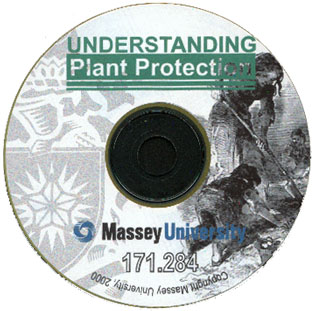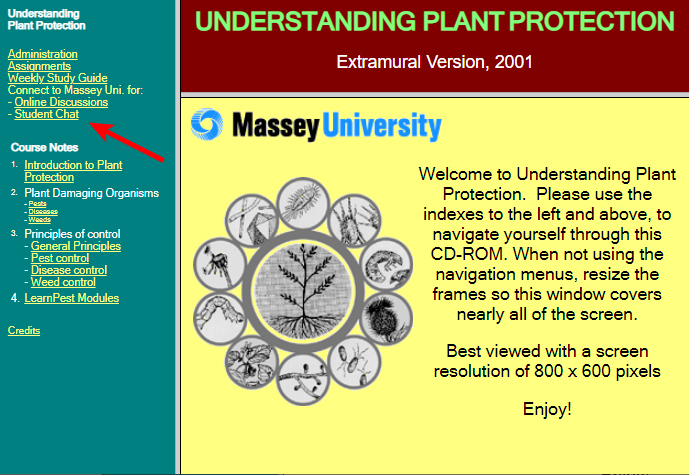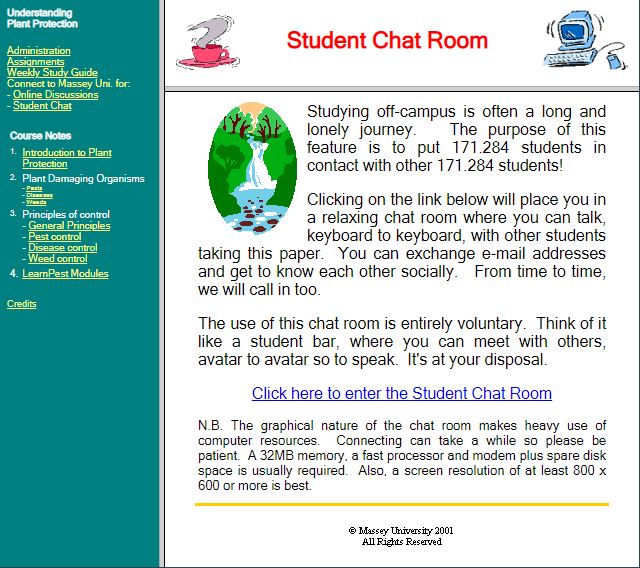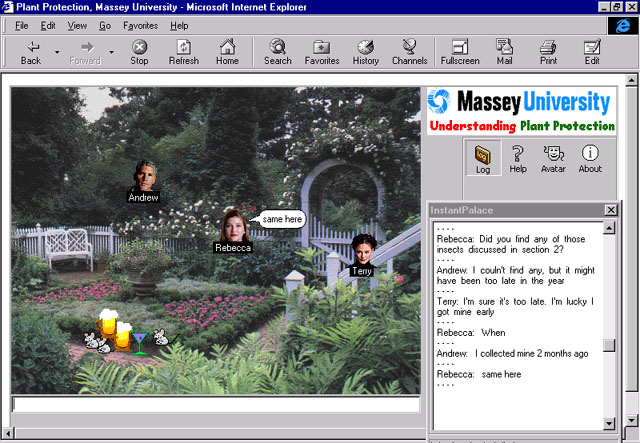| Tweet |
Worlds Inc. Worlds Chat and Time Warner's The Palace: Life in Two Graphical Chat Environments from 1995-2002 (Part 4)
This is Part Four of a multi-part article. If you haven't already, you may wish to read Part One, Two and Three first.
<--- Back to the beginning (Part 1)
<---Back to Part 3
Palace chat for education (1999 to 2001)
(i) Delivering a distance course electronically
In the last chapter, I wrote about my experiences using The Palace chat environment for on-line fun. However when I bought The Palace server I also had another use in mind: to facilitate course delivery at a distance.
Since the early 1980s I had overseen, and was the main contributor to, a University distance course in plant protection. Up until around 1995, this was entirely paper-based. This posed some challenges. Distance teaching relied a lot on colour photos and illustrations, especially for the sections on identification. Line drawings were included in a mailed-out study guide (which was essentially a textbook) and colour photos were provided in an accompanying booklet. After becoming familiar with HTML and a scanner, the booklet was replaced with a CD-ROM of HTML presented images from 1996-1998.
In 1999, those of us with large print content were encouraged to cut costs. I did this by replacing the printed study guide with a CD-ROM containing ALL of the course notes in HTML format. Students would study from the CD-ROM rather than paper, and the colour photos, rather than being sent separately, could be embedded directly in context in the text. Students still had the option to request hard copy if they wanted to. Typical student numbers around this time were about 30 or so.

Image 1. The course CD-ROM
Learning Management Systems were just getting off the ground at this stage and Massey University was looking into WebCT. My course was media-rich however, with large photos. Many distance students had very slow internet access at that time so large images took a while to download. This being the case, for now at least, I decided a CD-ROM delivery was the way to go.
Launched in 1999 my distance course was the second in the whole University to be delivered purely in a digital form.
The CD-ROM did have two (optional) components which required an Internet Connection. One was a discussion board and the other was a link to a Palace Chat server for informal and scheduled chat meetings.

Image 2. The index page on the CD-ROM. The red arrow shows the link to the Palace Student Chat
(ii) The chat room
The chat room, which used the Palace server, was open 24 hours, seven days a week for any student who wished to visit it. I encouraged them to use it for getting to know each other. I also scheduled weekly evening meetings in the chat room, to discuss the sections they were suppose to be reading and deal with any questions or issues.

Image 3. What the students saw when they clicked on the "Student Chat" link
(iii) InstantPalace
Now visiting a Palace server would normally require the Palace Client software. However, I didn't want my students to install and extra piece of software just to visit the chat room. Fortunately, the Palace Server had a nifty function called InstantPalace. This was a java-based application which meant that students could simply log in with their web browser to a nominated room. No extra software was needed. It was perfect for what I wanted!

Image 4. An InstantPalace session from the course
Image 4 shows the interface with three students chatting to each other. This kind of interaction with distance students wasn't common at the time and students, at least those who used it, seem to get value from it.
(iv) How successful was the chat room?
While the students appreciated the chat technology, I found that they seldom used the chat technology! Even my regular (voluntary) tutorials were only attended by a handful of people. These students seem to enjoy the sessions, but the vast majority of students never visited. The message boards were used far more! It seems the asynchronous method of communication was favoured. It makes sense really, as nearly all the students had full-time jobs and unless the chats were compulsory, or provided foundation content, there was little incentive to attend.
In 2002 I dropped the chat room from the course, although I kept the message board. I went on to offer the CD-ROM for a few more years until we adopted the Learning Management System Moodle, and the course went entirely online. By then, Internet access and speeds had improved and because the CD-ROM's content was entirely HTLM, it was a painless transition.
(v) Concluding thoughts
This ends my musings and memories on my chat experiences in the (relatively) early days of the Internet. It was fun, challenging and always a learning curve. In the end it was about community and creativity. 2D and 3D virtual worlds are common now, particularly in gaming. Cheaper and more accessible headsets and other hardware ensure an all encompassing experience. At the time of writing this I haven't experienced any of these virtual reality worlds like VRCHAT, but I sure I will. When I do, I'll probably get the same sense of wonder I had when I logged onto Worlds Chat 27.5 years ago!
Terry Stewart (Terry-NZ or Tez)
18th December, 2022
<--- Back to the beginning (Part 1)
<---Back to Part 3
| Tweet |